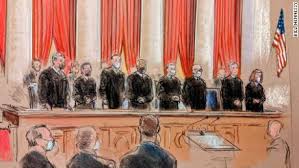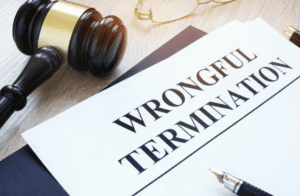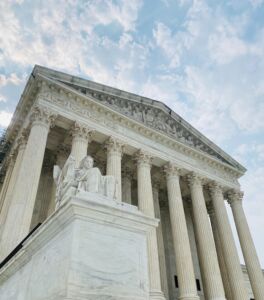On January 13, 2021, the U.S. Supreme Court made two major decisions. These related to President Biden’s attempts to increase the number of workers who are fully vaccinated against the coronavirus.
The first decision temporarily blocked the vaccinate-or-test regulation that applied to employers with 100 or more employees. The second decision allowed the vaccination requirement for health care workers at facilities that treat Medicare or Medicaid patients to stand.
Why did the Supreme Court come down differently in these two cases and what does it mean for the future of employment law, if anything?
A Brief Background of the Vaccine Mandates
In 2021, President Biden took steps to require many employees in the United States to get the coronavirus vaccine. These included the Occupational Safety and Health Administration (OSHA) releasing its COVID-19 Vaccination and Testing Emergency Temporary Standard (Vaccination and Testing ETS) and the Centers for Medicare and Medicaid Services (CMS) issuing its Omnibus COVID-19 Health Care Staff Vaccination Rule (Health Care Vaccination Rule).
The Vaccination and Testing ETS required employees working for large employers (100 or more employees) to either get the coronavirus vaccine or get regularly tested and wear face coverings at work. The Health Care Vaccination Rule was less accommodating. It required health care staff at Medicaid and Medicare certified providers and suppliers to become fully vaccinated against the coronavirus (unless a medical or religious exemption applied).
How These Cases Got to the Supreme Court So Quickly
Numerous lawsuits were filed in response to these mandates. With respect to the Vaccination and Testing ETS, the U.S. Court of Appeals for the Fifth Circuit placed a temporary stay on the regulation to keep it from going into effect until its substantive legal challenges could be addressed. This stay was then lifted by the U.S. Court of Appeals for the Sixth Circuit.
As for the Health Care Vaccination Rule, two federal district courts stayed enforcement of the rule until the merits of the underlying legal challenges could be decided.
After undergoing some case consolidation, these legal challenges were expedited to the Supreme Court to decide whether these vaccine mandates should be in effect or stayed until the lower courts could decide each case.
Why the Supreme Court Blocked the Vaccination and Testing ETS
To be clear, the Supreme Court didn’t permanently block the Vaccination and Testing ETS. Instead, it only agreed to pause its enforcement until the substantive legal challenges could be decided. Of course, given the quickly changing nature of the coronavirus and attempts to deal with it, by the time the case gets decided, OSHA may no longer wish to have this emergency temporary standard in effect.
The explanation the Supreme Court gave for temporarily blocking the Vaccination and Testing ETS is fairly straightforward. Basically, the Supreme Court said OSHA exceeded its statutory authority because it’s tasked with regulating occupational hazards, not everyday hazards that happen to occur in the workplace.
Yes, OSHA will sometimes regulate everyday hazards that occur in the workplace, such as rules about fire safety and sanitation. However, these rules are tailored to the specific characteristics of an industry or workplace.
For example, fire safety regulations are going to be different with an industrial plant manufacturing flammable chemicals as opposed to an average office filled with cubicles. Except for a few very small exceptions, the Vaccination and Testing ETS applies to all covered employees, regardless of where they work or what they do.
Another major difference between the Vaccination and Testing ETS and a sanitation or fire safety regulation is that getting a vaccine is permanent. It’s not as if workers can step away from vaccines at the end of the day like they would protective gear or workplace cleanliness standards.
The Supreme Court also recognized that instead of getting the vaccine, workers can agree to regular testing and wear an appropriate face covering at work. But the decision to give this option is up to the employer, not the employee.
Why the Supreme Court Allowed the Health Care Vaccination Rule to Stand
So why did the Supreme Court allow this vaccine mandate to stand, but strike down the more general one from OSHA? The short answer is that this regulation fell under the statutory authority granted by Congress to the CMS. As the Supreme Court put it, “a vaccination requirement under these circumstances is a straightforward and predictable example of the ‘health and safety’ regulations that Congress has authorized the Secretary [of Health and Human Services] to impose.”
Specifically, Congress has given the Secretary of Health and Human Services the power to place conditions on the receipt of Medicate and Medicaid funds. These conditions include maintaining the health and safety of health care workers and patients. Because of the health risks present with the coronavirus, it’s perfectly reasonable for CMS to create a rule that would drastically reduce the chances of health care workers getting infected with the coronavirus or spreading it to their patients.
As for the argument that CMS’ regulations should only concern the bureaucratic administration of Medicare and Medicaid, that’s never been the case. There have always been conditions that regulate the health and safety of health care settings that receive Medicare or Medicaid funding. These include which job duties certain medical professionals can engage in, how organs must be transported or the requirement that hospitals take steps to monitor, prevent and control infectious diseases.
What These Decisions Mean for Workers
There’s a broad message that can be gleaned from these two decisions: the Supreme Court doesn’t like the executive branch pushing the limits of its constitutional power. And a mandate that comes from a federal regulatory agency instead of the White House will still face the same (if not higher) level of judicial scrutiny.
What this could mean for employees in the future is that the Supreme Court will give a second look when a federal agency tries to grant further protection to workers by issuing new rules or engaging in other regulatory activities. And any future attempts to expand worker rights might need to come from Congress to better withstand legal challenges.
Summing It Up
Unlike many other cases, the legal theories relied on by the Supreme Court are fairly straightforward. In essence, the Supreme Court felt that CMS acted within its Congressional authority while OSHA exceeded it. But the Supreme Court also sent a subtle message that Congress, not federal agencies, are better suited for enacting legal requirements that would affect a large number of people.





